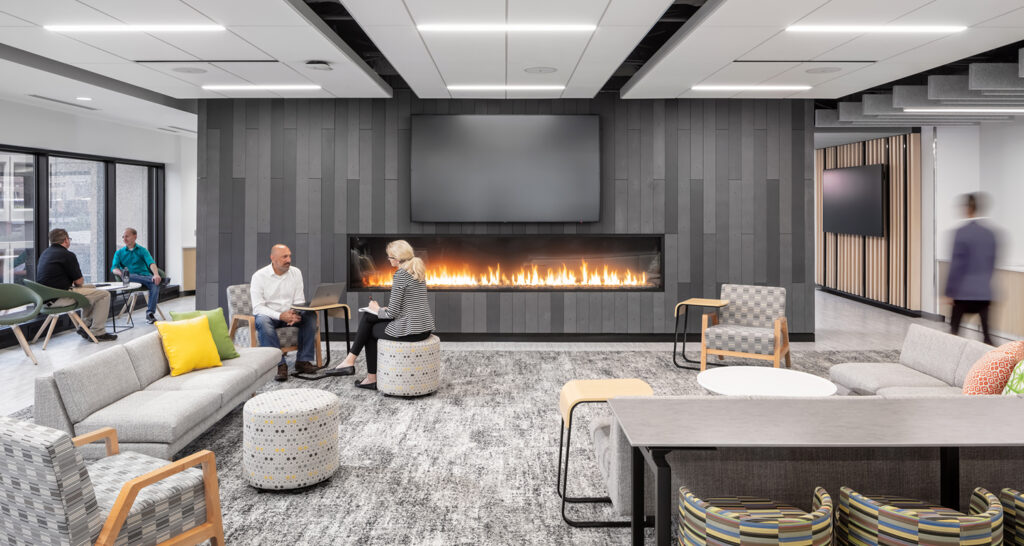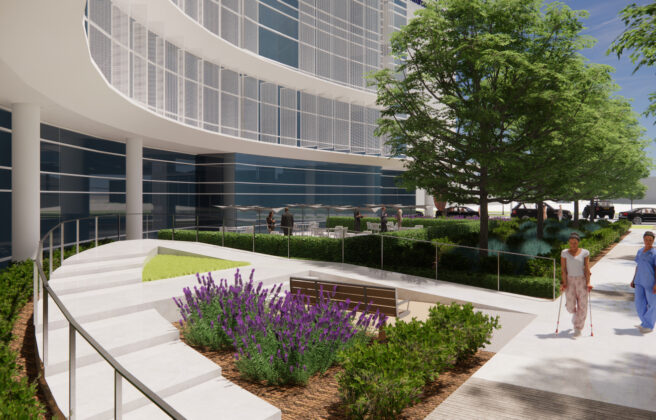Hybrid and remote work are now the norm across a wide range of industries, and while the shift was a long time coming, it was clearly accelerated by the pandemic.
But what happens when you work in an industry where place is everything? At BWBR, we literally design spaces for people to connect and collaborate. How do we reconcile that with our own work policies? BWBR project manager and architect Jarett Anderson hosted a conversation with senior project manager Mallory Furlong and principal and operations director Stefnee Trzpuc to talk about it.
FLEXForward
BWBR embraces a flexible hybrid work approach that we call FLEXForward. It allows employees to decide how they best do their work. The three flex options are resident (on-site), hybrid, and distant (remote). Stefnee explains that hybrid is the dominant model chosen by current BWBR staff, who come in to the office somewhere between one and four days per week. “Individual work styles are really important to how we design the future of our work,” she says. “As a hybrid organization, we need to understand what it means to thrive as hybrid in our design processes, our operations, our teams, our tools, how we serve our clients, and how we use our physical and virtual space.”
Indeed, hybrid is arguably the most challenging of the three options within the Flex Forward approach. When a team is in the office full-time, it’s easy to plan for that. It’s also easy to plan for a fully remote team. The hybrid approach demands a workspace that’s flexible, that provides enough desks for people to get work done and enough meeting space for people to have sessions together, and space to accommodate small cohort brainstorming all the way to large team gatherings.
Fortunately, creatively and strategically designed spaces are something we know a thing or two about.
Creating Space
When considering a structure like FLEXForward, Stefnee recommends that organizations pursue team agreements. Team agreements involve a group agreeing to standards of how to approach a project, when people are going to be available, what tasks need to get done, how often they’re going to gather in person, where they’ll gather, and so on. Establishing these standards up front paves the way for fewer roadblocks and miscommunication down the road — and can also help a team consider the physical spaces they’ll need to support their agreements.
Mallory adds that even the most well thought out agreements demand room for flexibility. Perhaps initially, a group thought it was realistic to all get together on Tuesdays and meet for half-days on Thursdays, but that doesn’t turn out to be practical. Other workload creeps up, or there’s an illness, or family obligations get in the way. For Mallory, transparency is key in instances like this: “We’re all people, and even when we have a plan, those plans can be interrupted. Open the door for conversations with your teams and be transparent about what’s happening and what you need.”
Having flexible physical spaces can help teams navigate uncertainty in hybrid schedules, too. It might not make sense to dedicate a large office space to one function, but what if it can flex and be a brainstorming room, extra workspace, a place to cater in lunch, or whatever the moment calls for? For this to work, design is key. Nobody wants to do their best creative work in a place that’s clearly meant to be a cafeteria, or vice-versa.
Collaboration Above All
Regardless of whether the BWBR team is on Zoom or in the office together — or some of both — collaboration must be at the heart of everything. BWBR’s culture is built on collaboration and mentoring and sharing ideas. Distinct perspectives and the inherent tensions that spring from those distinctions are fundamental to creating exceptional environments that transform lives. That means we need to be intentional about how we connect, even if we’re not in the same room.
We want that for our clients, too. Around the world, organizations are reimagining their professional spaces and wondering how they can create the best path forward. How can they cater to flexible work structures? How can they best serve their clientele in inspiring spaces when the future is uncertain?
Hybrid work is a major design challenge, but it also opens up new possibilities to redesign spaces to facilitate the flow of knowledge throughout an organization, within and beyond its walls. The world now knows that collaboration doesn’t always require physical presence, but at the same time, having occasions to get together make those opportunities even more impactful — and demand spaces that can harness the moment.
Better For All
Mallory and Stefnee agree that a major plus of the FLEXForward structure is that it invites people to bring their best selves to work, giving everyone agency to decide how and where they work best. Says Stefnee, “if we can all bring our best selves to work and build deep relationships, balancing team needs and employee needs, we’ll not only have better experiences as an organization, but we’ll also come up with better design solutions for our clients.”








